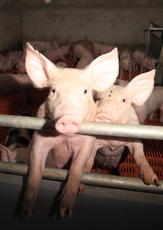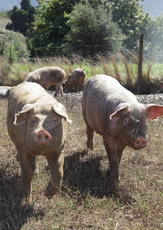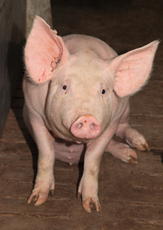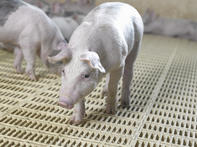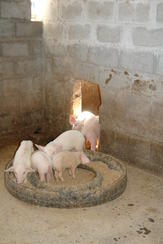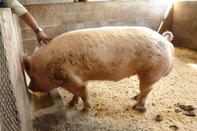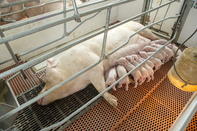
Monitoring Pig Health
Pig Farming in South Africa
Under normal conditions, pigs will be playful, inquisitive and act as part of the group.
The key with pig health management is to identify problems and diseases before they get out of control. To do so, farmers need to distinguish between normal and abnormal behaviour and health symptoms.
Social Creatures
Pigs should be moving easily.
Pigs are social intelligent animals. Under normal conditions, they will be playful, inquisitive and act as part of the group. They will show interest when somebody enters the production area and may react to a noise by looking in the direction of the sound. When ill, they may withdraw from the group, become lethargic and listless. They may also be rejected by other pigs, which may result in the altering of the group’s lying pattern.
Movement
The face should be clean with no discharges from the eyes.
Pigs should be moving easily. Pigs separating themselves from the rest of the group, a lack of vitality and vigour, walking difficulty, difficulty in getting up or pigs becoming confined to the floor, are signs that something is wrong.
Ears, Eyes and Nose
The face should be clean with no discharges from the eyes. Dull eyes, droopy ears or ears pointing downwards may indicate that a pig is feeling unwell. Nasal secretions should be light coloured and not turbid, pustulent or bloody.
Coats
The coat should be shiny and healthy looking. Black and coloured pigs generally have thick hair, whereas modern white breeds have little hair that lie flat. Raised hair, dull hair and mangy patches are all indications that something is wrong.
Skin
©National Pork Board and the Pork Checkoff, Des Moines, IA, USA
The skin and coat of the skin should look healthy.
The skin should be clean without wounds, scabs, discoloured patches, lesions or thickenings. According to the Pig Site article Recognising disease on the farm, a blueing of the extremities may be associated with viral infections, acute bacterial septicaemia, a toxicity, acute mastitis, metritis, acute pneumonia and various other diseases. In white skin-coloured pigs the reddening of the skin may also be an indication of disease or infection.
Respiration Rate
A healthy pig will breathe steadily and easily. The normal respiratory rate of a pig depends on its age: A healthy newborn’s being about 50 to 60 breaths per minute, a weaner’s ranging between 25 to 40 breaths per minute and that of an adult pigs being 13 to 18 breaths per minute.
Heartbeat
The normal heartbeat of a mature pig is 65 to 80 beats per minute and below 180 beats per minute for newborns.
Body Temperature
The normal body temperature of a pig is between 38,5 and 39 Degrees Celsius. A pig with a temperature above 41 degrees Celsius or below 37 degrees Celsius is seriously ill. Something is wrong if a pig is shivering.
Appetite
Something is wrong if a pig loses its appetite.
Something is wrong if a pig loses its interest in feed.
Excretions
Dung should be firm with a cow pad consistency.
Urine should be light yellow to water coloured. Dark yellow, purulent or blood-tinged urine is abnormal. A pig that has stopped urinating is deadly sick.
The dung should be firm with a cow pat consistency. Constipation, watery to mucoid or bloody diarrhoea are not normal.
Milk Flow
©National Pork Board and the Pork Checkoff, Des Moines, IA, USA
Piglets nursing under heating lamp: Sows should produce enough milk for each piglet.
There should be enough milk for each piglet, in other words, each piglet should be round and content. Something is wrong if a sow’s udder is hard and swollen, if she does not produce sufficient or any milk or there are litter deaths.
Smell
Use your sense of smell to identify problems, such as poor ventilation, high levels of gasses or high or low humidity levels, bad feed and even dead animals. What is uncomfortable for humans is most likely also uncomfortable for pigs.
By
Glenneis Kriel